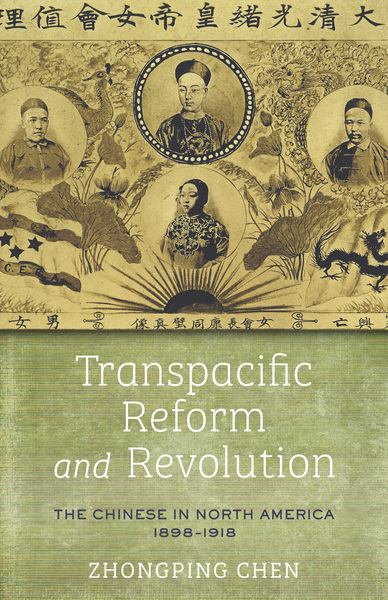
Transpacific Reform and Revolution: The Chinese in North America, 1898-1918
Review By Letian Wang
June 26, 2024
BC Studies no. 222 Summer 2024 | p. 165-167
While many may be familiar with the significance of the late Qing constitutional reform and the 1911 Republic Revolution in Chinese history, fewer, including British Columbians, recognize the centrality of British Columbia in these two movements. Through his unique “local-centred,” as opposed to the conventional “locally contained” perspective (14), Zhongping Chen highlights the significant impact that this coastal province had on not only shaping political developments in China but also transforming the global Chinese diaspora.
The first two chapters discuss the exile years of Qing reformer Kang Youwei. Kang’s collaborations with the Chinese communities in Victoria and Vancouver in 1899 persuaded him to found the Chinese Empire Reform Association (CERA) to advocate for his reformist political objectives among overseas Chinese, while adapting his reformist agenda to encompass issues resonating with the local Chinese population, such as anti-racism. Kang’s reliance on interpersonal connections led to significant success in expanding CERA. However, this reliance also introduced conflicting personal and familial interests, ultimately contributing to the decline of CERA around 1909.
The third chapter centers on the endeavors of Sun Yat-sen, often regarded as the “father of modern China,” and his associates in rallying the overseas Chinese for their revolutionary cause in China. Importantly, Sun benefited from CERA’s decline and embraced Kang’s strategy that relied on networks for garnering support, but further formalized, politicized, and institutionalized his revolutionary organization. Consequently, as elaborated in the final chapter, this led to intensified partisan infights that inevitably politicized and divided the transpacific Chinese diaspora.
This book challenges traditional narratives depicting Chinese Canadians as passive followers of those “great men” in Chinese history. Instead, it portrays them as pioneers in the quest for a stronger country modelled on Western political systems. Chen demonstrates that Sun’s collaborations with the Chinese in Victoria even made this provincial capital Sun’s “pivot from previous failure to future successes” (156). The author also illuminates a frequently overlooked dimension of Chinese Canadian history: Chinese women. In 1903, Victoria witnessed the inception of the first women’s political organization in both Chinese diasporic and Chinese histories: Chinese Empire Ladies Reform Association, with affiliation to CERA. At its peak, the Vancouver chapter recruited almost all women in the city’s Chinatown. (94).
Chen’s unique methodology of “network analysis” enhances this transnational history. Its focus on the interconnection between different figures, spanning from Chinese politicians to business tycoons in BC Chinatowns, ably supports his analysis of spatial shifts between both sides of the Pacific. Using network as a key link between all the historical changes, Chen portrays the twenty-year transformation in the transpacific Chinese diaspora as essentially a “network revolution.” It began from traditional networks rooted in interpersonal relations, such as surname associations, progressing toward more institutionalized, politicized, and formalized networks, such as Kang’s CERA and Sun’s Chinese Nationalist League.
Merits, however, are balanced by two shortcomings. Firstly, Chen does not offer adequate theoretical explanations for his complex methodology of “network analysis.” Additionally, the author neglects to contextualize his “network analysis” within the Chinese Canadian and Chinese diasporic cultural context. Considering that networks are inherently influenced by culture, the absence of this contextualization could impede the narrative’s coherence and depth. The second is that Chen fails to recognize the role of the Chinese Canadian commoners who were not powerful members of all the “networks.” Acknowledging the role of Chinese Canadian merchant elites while overlooking the contributions of laborers is indeed a significant oversight.
A highlight of this book is its unusually rich source selection. Drawing from archival resources and academic scholarships from both sides of the Pacific Ocean, Chen indicates a new direction that transnational history is not merely a perspective looking beyond national borders, but also requires a transnational source selection. Combined with professional historical analysis, the author was able to aim at correcting mistakes in “oral history, self-publication and academic works” (15). Throughout the book, Chen fixes errors by David T.H. Lee, David Chuenyan Lai, and Edgar Wickberg, three founding scholars of Chinese Canadian history. Chen corrected errors on Kang’s second visit to Canada in 1899 (33), on the origin of CERA in BC (40), on Kang’s mysterious Canadian trip in 1902 (65), on Kang’s final Canadian trip in 1909 (79), on the demographic structure of Canada’s CERA (80), and on the motive of a notorious murder case in Victoria’s Chinatown in 1918 (211). Based on extensive research and careful examination of these critical topics, Chen’s corrections will guide future scholars towards more accurate interpretations, preventing the perpetuation of misinformation.
As an esteemed scholar renowned for his expertise in Chinese history, Chen’s inaugural book on Chinese Canadian history erects a new landmark within this scholarly domain: it points out a transnational direction, offers a transnationally selected, extensive amount of source materials, illuminates the gender aspect, adds new methodology, and corrects errors of earlier historians. Written in concise and clear language, this book can appeal to a general readership. Scholars in Asian Canadian history will find this book particularly valuable for its contribution to this field.
Publication Information
Chen, Zhongping. Transpacific Reform and Revolution: The Chinese in North America, 1898-1918. Redwood City, CA: Stanford University Press. 2023. 404 pp. $70.00 hardcover.
